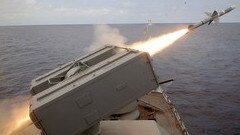How to protect Australia’s missile supply chains
With the government planning to spend upwards of $100bn on guided weapons in the next two decades, what’s the big picture?

Missiles have become very big business. With the government planning to spend upwards of $100bn on guided weapons over the next two decades, it’s not surprising that we’re seeing lots of announcements out of government and industry about missiles. But it’s hard to make sense of the scattershot approach. What’s the big picture here?
It’s useful to distinguish between supply and demand factors. The demand side is stated clearly in the government’s 2020 Defence Strategic Update, which says that the ADF’s capabilities are largely defensive and incapable of deterring a powerful adversary. Consequently, it needs a range of new long-range strike capabilities.
In short, Australia is having to play catch up with China’s high-end, long-range systems. It also needs to deal with the reality of the proliferation of the low-cost but technically advanced weapons such as those that were brutally effective in the Azerbaijan-Armenian conflict and are now available to any country that wants them.
That means greater investment in defensive missiles to protect our forces and offensive ones to shoot back. That’s driving the $100bn demand.
So far, we’ve seen the government announce the acquisition of new long-range strike weapons for the army, navy, and air force.
On the supply side, the government and Defence are working out how to assure the supply of these crucial weapons in time of conflict. Just-in-time supply chains don’t work well for missiles.
Even in peacetime orders can take years to arrive. As we saw when Covid-19 struck, in times of crisis supply chains fall apart – and wars are exercises in destroying the other side’s supply chain. In essence, the $100bn program is a strategy for managing supply chain risk.
Whether we are talking about ventilators or missiles, there’s broadly four approaches you can take to address supply chain risks. We can see all of them at work in the government’s strategy and all of them will require Australian industry to step up.
The first is to stockpile. Defence has traditionally maintained limited stockpiles of guided weapons due to their cost. That’s changing. Defence’s acquisition plan has a $20.3-$30.4bn funding line for weapons inventory.
Regardless of where those weapons come from, storing, maintaining, certifying, and transporting a much bigger inventory is going to require a big step up from Australian industry.
The second is to get inside the tent with trusted suppliers to share risk.
We’re seeing that happen with the announcement of Australia joining co-operative programs with the US on advanced weapons such as the SM-6 long-range air defence missile and hypersonics.
This approach was used to develop and produce the Evolved Sea Sparrow Missile and worked well in developing Australian industry capability.
The third one gets all the attention, namely establishing domestic production.
The government flagged this as a possibility in last year’s strategic update, but one gets the feeling that its announcement in March this year that it actually was going to establish a guided weapons manufacturing capability took Defence by surprise. Since then, the department has been scrambling to work out what that will look like.
At the moment Defence is looking for the right industry partners.
This could mean choosing a single prime partner like Raytheon, which has a broad portfolio of weapons already used by the ADF, to manufacture some of them here. Or it could mean choosing a range of partners, both local and overseas, who would contribute parts of the enterprise.
The solution will likely involve elements of both paths. Already we can see Australian industry self-organising into entities that can provide many of the capabilities needed for missile production, such the Sovereign Missile Alliance and the Australian Missile Corporation.
But while nearly all components of missiles can be produced in Australia, in the short to medium term at least we’re still going to need overseas partners who already have mature missile designs.
Just as importantly, we’ll need the US Congress to release the intellectual property required to build missiles under licence here. This could be another outcome to pursue through the recent AUKUS announcement.
Our reliance on the US brings us to the final strand of a supply chain strategy. That’s to diversify suppliers.
We’re heavily reliant on the US for guided weapons. That has advantages for interoperability and access to leading technology. But it also makes sense to hedge.
The government has already started to do that by selecting the Israeli Spike antitank missile for assembly in Australia. And there are European manufacturers who are keen to establish missile production here and aren’t encumbered by the US’s restrictions.
The key to success will depend on aligning supply and demand. We can’t do everything here, so we need to make sure we focus on building the right guided weapons here.
Defence also needs to generate sufficient economies of scale to justify establishing production lines here; that could mean directing that all three services use the same missile across a range of platforms.
Getting this right is vital to making sure the ADF has reliable supplies of the weapons that will be essential to success in future conflict.
-
Marcus Hellyer is ASPI’s senior analyst for defence economics and capability.


